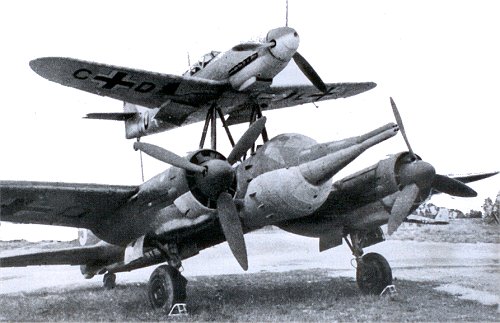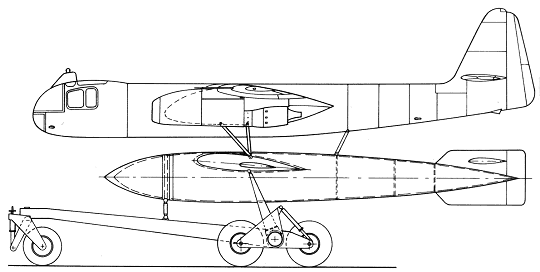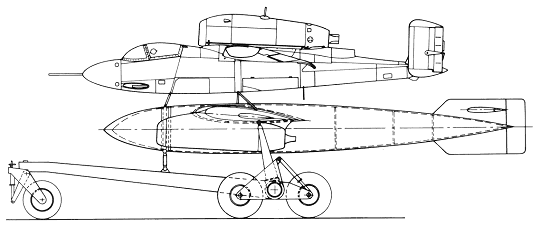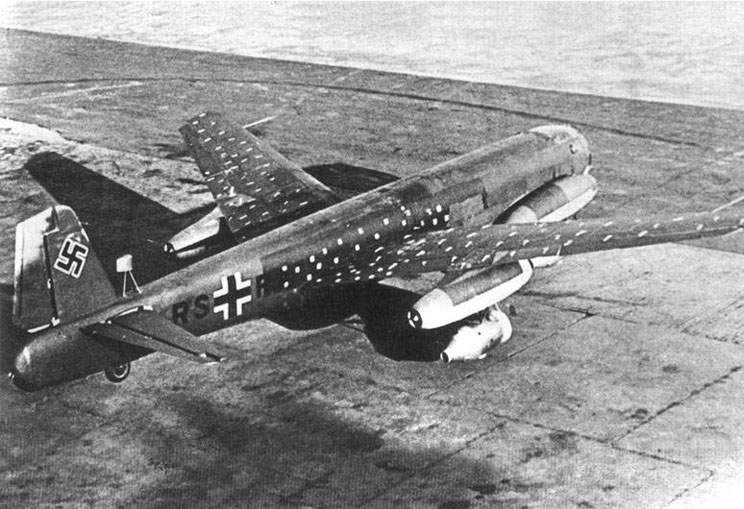Were there any missions that actualy worked?
Hmmm, as far I remember the answer is no, at list no fully successful, there was some good results against bridges and russian fortified emplacements but none really espectacular. I going to check out in the book for more info about the actual use in combat.

Youre kinda like our own portal to a library of WWII books. 
I just doing my best.
I find a little more.



Extract form “Mistel, The Piggyback aircraft of the Luftwaffe” wich is a
translation of Mistel. Die Huckepack- Flugzeuge der Luftwaffe bis 1945 by Hans peter Dabrowski originally published by Podzun-Pallas Verlag in 1992.
I saw sometime ago a docu in the german DW-TV about the war, the mistel was briefly named, in that show one of the big holes caused by Mistel attacking the Oder bridges was depicted…it is still there and it was huge.

I’ve found two sites about the Mistel projects, there are a few details that differ could anyone shed any light?
http://http://www.geocities.com/Heartland/Village/4082/mistel/mistel.htm
http://http://www.warbirdsresourcegroup.org/LRG/mistral.html
Bascially:-
Which one is correct for the Mistel 3A Ju 88A-6 & Fw 190A-6 or Ju 88A-4 & Fw 190A-8?
Is the Mistel 3B the ‘Mistel Führungsmaschine’ or is it a completely different Mistel variant?
Is there a Mistel 6 comprising the Ar E377 & Ar 234C?
Also are there any projects missing from either site?
Thanks in advance
The red Dragon
lots of mistels were fabricated by modelers and/or model companies like the he162/me262 mistel. Pzk oughta know.
Is the Mistel 3B the ‘Mistel Führungsmaschine’ or is it a completely different Mistel variant?
It is a completey different variant, the führungsmachine ( guiding machine or leading machine) was a long range ju-88 H variant with the exploration Fug “Berlin” radar below the nose, this was used as navegation and ship finding apparatus, then it should “guide” the combat mistel precisely to the enemy fleet.

The combination was also proposed as early warning aircraft using its radar fo find and guide the stream of fighters agaist the allied bomber packs.
The upper FW-190A-8 was used only as an escort plane, so it would be launched in case to find enemy fighters, it became what is normally called “parasite combination”.
The other part of your question …I have made a search for it.
Thanks for that, i’m trying to compile a list of parisite and Mistel combinations actual or planned. 
The Hohlladung (called “Elephant-Mine” in the Danish post war newspaper where I read this) was trialled against “Møns Klint” (Baltic coast) in Denmark in 1944, when a Mistel was flown into it. “Møns Klint” ia a cliff much like those at Dover. The Germans had advertised the local population to stay away on that certain day, which of course meant that the resistance movement was there to see (and report on to London) what was going on.
The explosion could be heard far and wide.
Some more blurry pics, even not the best quality those give an idea of the size of the shaped charge.


This hohlladung could penetrate 10 meters of reinforced concrete or 4 meters steel armor.
Wow. biiiiiiiiig panzerfaust…
Wasnt there a Ju290Z/me328?
Wasnt there a Ju290Z/me328?
Just on paper Walther, just on paper.:!:
Mistel training variants.

Here this is one I found.

Nein Pzk, Im walter

Ok, I ll spare the “h”.
[LEFT]Arado Ar E.377
This Mistel project was one of the last glide bomb developments submitted to the RLM before the end of WWII. Arado, working with Rheinmetall-Borsig, designed a simple glide bomb that could be powered or unpowered, and carried beneath the Arado 234 or Heinkel 162. The purpose of this flying bomb, which could be guided by remote control or a target guidance system, was to attack targets such as ships or large fixed objectives.
Construction of the E.377 was wooden throughout the entire aircraft. The fuselage was circular in cross section and was cigar-shaped. Mounted in the nose was 2000 kg (4408 lbs) of Trialen 105, a high-explosive especially suitable for ship attacks. In addition 500 kg (1202 lbs) of an incinderary liquid was stored in the rear fusleage which also acted as ballast to counterbalance the forward warhead. A standard SC 1800 bomb could also be fitted in the forward fuselage of the E.377 in place of the other explosive.
The wings were tapered and shoulder mounted. They also served as auxiallary fuel tanks for the parent aircraft. Fuel was drawn from the E.377’s tanks by means of jet pressure which drove a compressor in the powerplant of the parent aircraft.The tail unit was symmetrical on top and bottom with a horizontal tail mounted on the upper half of the fin.

Take off was accomplished by means of a releasable trolley which was similar to one that Rheinmetall-Borsig had designed for the Arado 234A. Since the Ar E.377 [i]Mistel[/i] was heavier, an extra set of wheels were added to the new trolley. Once the aircraft reached takeoff speed, the trolley was released and slowed with a parachute and rockets. Assembly of this [i]Mistel[/i] was carried out using a special trestle and frame to add each aircraft on top of the trolley.

Upon arrival at the target, the E.377 was released by means of explosive bolts and then was terred to it's target by means of a control device. This device made adjustments in the control and rudder movements from the carrier aircraft after launch, or the E.377 could just be set to glide straight after seperation.
There was also a twin BMW 003 jet powered version to be used with the Heinkel 162, since the single jet engine of the He 162 would not have been powerful enough to carry the E.377. This version was known as the E.377a and was similar in all other aspects to the E.377. A piloted version was also planned, to be a suicide weapon, but was cancelled before the end of the war. The E.377 was never constructed due to the end of the war.
i think there was a He177/Ar234R(ar234 recon with rockets instead of jet) combo.
i think there was a He177/Ar234R(ar234 recon with rockets instead of jet) combo.
Are you sure ? I sought several sources but I cant find anything. Not even as projekt.
6/KG 200 badge “Father and son”

Alas, even the Nazis have a sense of humor…
I guess you would be interested. Ju-287V1 is prepearing for the very first test flight.

source: http://gunter-spb.livejournal.com/361116.html
an one more:

messed up he 177 I heard…
